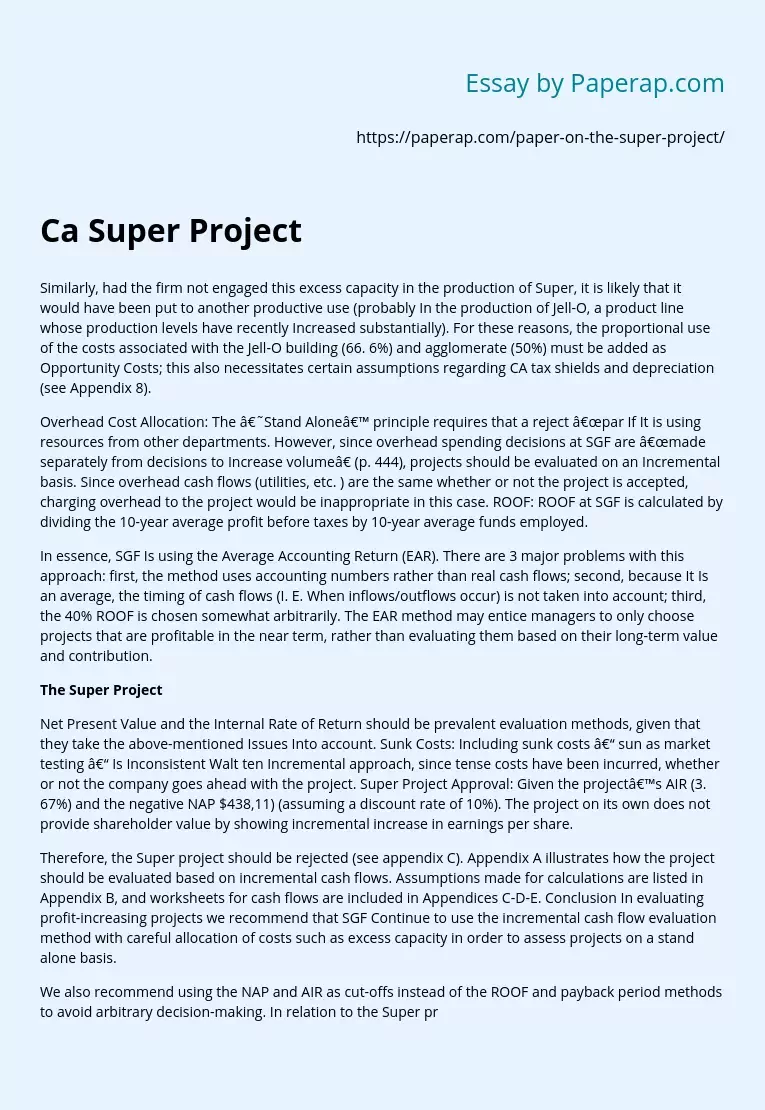Ca Super Project
Similarly, had the firm not engaged this excess capacity in the production of Super, it is likely that it would have been put to another productive use (probably In the production of Jell-O, a product line whose production levels have recently Increased substantially). For these reasons, the proportional use of the costs associated with the Jell-O building (66. 6%) and agglomerate (50%) must be added as Opportunity Costs; this also necessitates certain assumptions regarding CA tax shields and depreciation (see Appendix 8).
Overhead Cost Allocation: The ‘Stand Alone’ principle requires that a reject “par If It is using resources from other departments.
However, since overhead spending decisions at SGF are “made separately from decisions to Increase volume” (p. 444), projects should be evaluated on an Incremental basis. Since overhead cash flows (utilities, etc. ) are the same whether or not the project is accepted, charging overhead to the project would be inappropriate in this case. ROOF: ROOF at SGF is calculated by dividing the 10-year average profit before taxes by 10-year average funds employed.
In essence, SGF Is using the Average Accounting Return (EAR). There are 3 major problems with this approach: first, the method uses accounting numbers rather than real cash flows; second, because It Is an average, the timing of cash flows (I. E. When inflows/outflows occur) is not taken into account; third, the 40% ROOF is chosen somewhat arbitrarily. The EAR method may entice managers to only choose projects that are profitable in the near term, rather than evaluating them based on their long-term value and contribution.
Net Present Value and the Internal Rate of Return should be prevalent evaluation methods, given that they take the above-mentioned Issues Into account. Sunk Costs: Including sunk costs – sun as market testing – Is Inconsistent Walt ten Incremental approach, since tense costs have been incurred, whether or not the company goes ahead with the project. Super Project Approval: Given the project’s AIR (3. 67%) and the negative NAP $438,11) (assuming a discount rate of 10%). The project on its own does not provide shareholder value by showing incremental increase in earnings per share.
Therefore, the Super project should be rejected (see appendix C). Appendix A illustrates how the project should be evaluated based on incremental cash flows. Assumptions made for calculations are listed in Appendix B, and worksheets for cash flows are included in Appendices C-D-E. Conclusion In evaluating profit-increasing projects we recommend that SGF Continue to use the incremental cash flow evaluation method with careful allocation of costs such as excess capacity in order to assess projects on a stand alone basis.
We also recommend using the NAP and AIR as cut-offs instead of the ROOF and payback period methods to avoid arbitrary decision-making. In relation to the Super project, SGF must account for the excess capacity that would e use by Super, ignore overhead and sunk costs, and use the incremental cash flow analysis method. Following this criteria, and assuming an interest rate of 10% we recommend that the Super Project be rejected because its NAP is -$438,11 ; 1. Super project could only be accepted with a discount of 2. 50% or less, where NAP will be positive.
Ca Super Project. (2019, Dec 05). Retrieved from https://paperap.com/paper-on-the-super-project/

